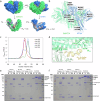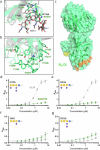Activity of botulinum neurotoxin X and its structure when shielded by a non-toxic non-hemagglutinin protein
- PMID: 39138288
- PMCID: PMC11322297
- DOI: 10.1038/s42004-024-01262-8
Activity of botulinum neurotoxin X and its structure when shielded by a non-toxic non-hemagglutinin protein
Abstract
Botulinum neurotoxins (BoNTs) are the most potent toxins known and are used to treat an increasing number of medical disorders. All BoNTs are naturally co-expressed with a protective partner protein (NTNH) with which they form a 300 kDa complex, to resist acidic and proteolytic attack from the digestive tract. We have previously identified a new botulinum neurotoxin serotype, BoNT/X, that has unique and therapeutically attractive properties. We present the cryo-EM structure of the BoNT/X-NTNH/X complex and the crystal structure of the isolated NTNH protein. Unexpectedly, the BoNT/X complex is stable and protease-resistant at both neutral and acidic pH and disassembles only in alkaline conditions. Using the stabilizing effect of NTNH, we isolated BoNT/X and showed that it has very low potency both in vitro and in vivo. Given the high catalytic activity and translocation efficacy of BoNT/X, low activity of the full toxin is likely due to the receptor-binding domain, which presents very weak ganglioside binding and exposed hydrophobic surfaces.
© 2024. The Author(s).
Conflict of interest statement
P.S. and M.D. are inventors on patents regarding BoNT/X. M.B., D.B., M.E., J.P., S.D., and F.H. are employees of Ipsen. The authors declare no additional conflict of interest.
Figures





References
Grants and funding
LinkOut - more resources
Full Text Sources

